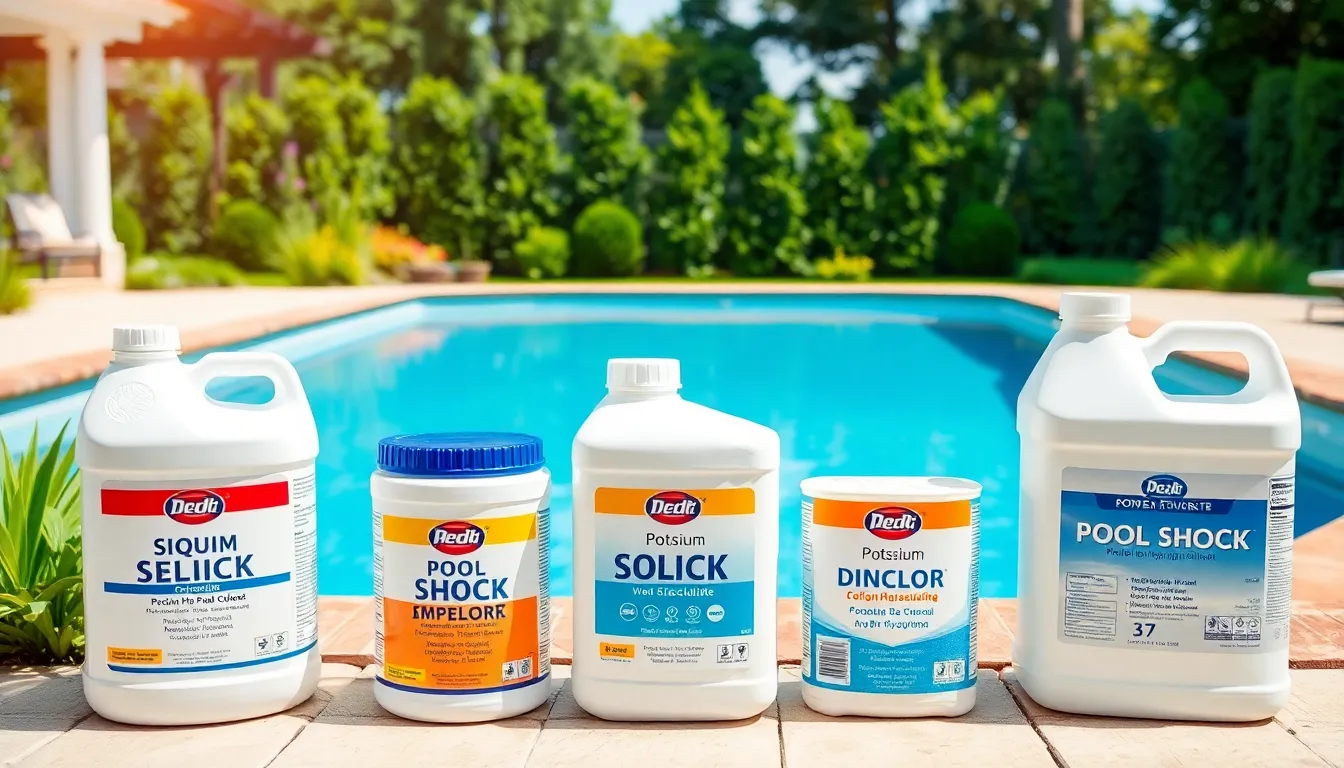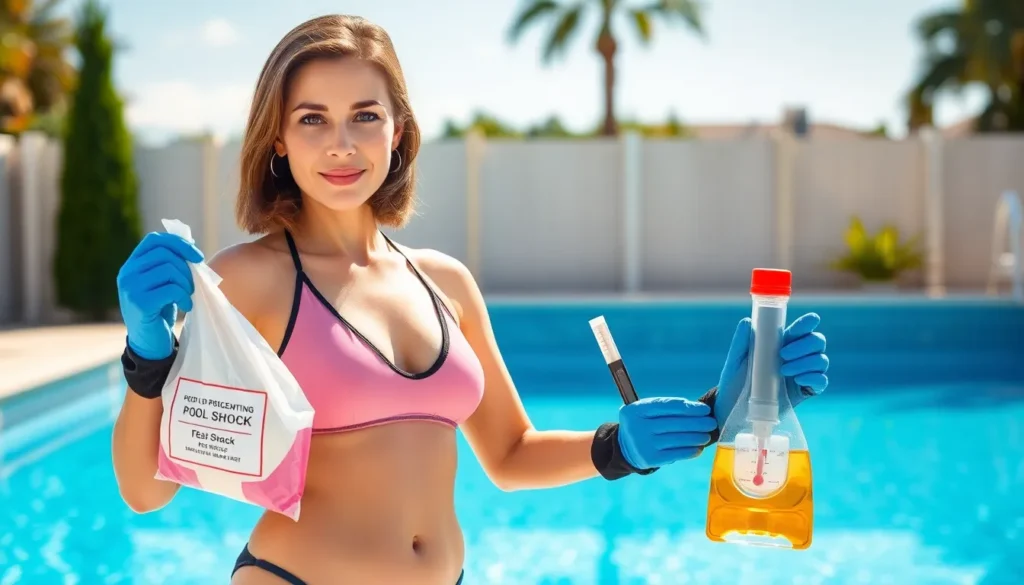Table of Contents
ToggleWhen summer rolls around, nothing beats the joy of a sparkling pool ready for cannonballs and lazy floats. But before diving in, there’s one essential ingredient that can make or break the fun: pool shock. Think of it as a superhero for your pool, swooping in to save the day from pesky bacteria and algae. Without it, your pool could turn into a green swamp quicker than you can say “Marco Polo.”
What Is Pool Shock?
Pool shock refers to a process involving the application of a chemical treatment designed to sanitize pool water. This method effectively eliminates bacteria, algae, and other contaminants. Commonly, pool shock contains chlorine or non-chlorine compounds, both contributing to cleaner water.
Applying pool shock serves multiple functions in maintaining pool hygiene. Shock treatments quickly raise chlorine levels, breaking down contaminants. Regular shock treatments prevent the growth of algae and ensure water clarity. Proper use of pool shock enhances the overall swimming experience.
Typically, people use pool shock after heavy pool use, rainstorms, or when water appears cloudy. The frequency of application varies based on pool conditions and type. Weekly treatments often suffice for residential pools, while commercial pools may require more frequent shocks.
Understanding the type of pool shock is crucial. For instance, calcium hypochlorite is a popular choice due to its effectiveness and ease of use. Alternatively, potassium peroxymonosulfate, a non-chlorine shock, provides a valuable option for those concerned about chlorine levels.
Storage and handling also warrant attention. Pool shock products should remain in a cool, dry place, away from direct sunlight and moisture. Proper safety measures include wearing gloves and goggles during handling to avoid skin irritation.
Conducting routine testing of pool water before shocking yields optimal results. Testing kits measure free chlorine levels, ensuring accurate treatment. Maintaining the right balance of chemicals prevents future issues and promotes a safe swimming environment.
Types of Pool Shock

Understanding the different types of pool shock is essential for effective pool maintenance. Each type serves specific purposes and offers unique benefits.
Calcium Hypochlorite
Calcium hypochlorite acts as a powerful sanitizer. This type of shock quickly raises chlorine levels, effectively eliminating bacteria and organic matter. Users appreciate its high chlorine concentration, often around 65 percent. Regular usage helps maintain clear water and prevents algae growth. It’s ideal for regular shock treatments, especially during warm weather. Proper storage in a cool, dry place ensures longevity. When applying, ensure water circulation to maximize effectiveness.
Sodium Dichlor
Sodium dichlor is a favored choice for pool care. This type is stabilized, meaning it resists degradation from sunlight. It generally has a chlorine concentration of about 56 percent and dissolves quickly in water. Pool owners often choose sodium dichlor for its slow-release properties, allowing for longer-lasting sanitation. It’s particularly useful for shock treatments following heavy pool usage or rain. Consider routine application to keep water balanced and clean. Ensure proper handling to avoid exposure to moisture.
Potassium Monopersulfate
Potassium monopersulfate serves as a non-chlorine shock treatment. Its effectiveness lies in its ability to oxidize contaminants without raising chlorine levels immediately. This makes it excellent for swimmers sensitive to chlorine. Users find that it enhances water clarity and improves overall sanitation. Potassium monopersulfate works well for regular maintenance, often required after heavy rains or pool parties. It’s essential to shock the pool during low usage periods for optimal results. Store it in a cool, dry area to maintain its efficacy.
How to Use Pool Shock
Correct use of pool shock ensures clean and safe swimming water. Regularly shocking the pool maintains optimal sanitation levels.
Frequency of Use
Application frequency of pool shock depends on usage and water quality. Weekly treatments often suffice for residential pools, while commercial pools benefit from bi-weekly or even weekly shocks. Heavy rainfall, increased swimmer traffic, or high temperatures may necessitate additional shocks. Monitoring chlorine levels can guide the need for extra treatments. Regular testing helps determine the right timing to apply shock.
Proper Application Techniques
Proper application techniques maximize the effectiveness of pool shock. Begin by testing the water to ensure balanced pH and chlorine levels. Always wear protective gear, such as gloves and goggles, to safeguard against irritation. Dissolve granular shock in a bucket of water before adding it to the pool. Pour the solution evenly around the pool’s perimeter. Wait a minimum of 8 hours, or until chlorine levels drop to a safe range before swimming. Using shock during evening hours helps avoid rapid degradation from sunlight.
Benefits of Using Pool Shock
Pool shock offers essential advantages for maintaining a clean swimming environment. It effectively sanitizes water, ensuring safety and enjoyment.
Water Clarity
Maintaining water clarity is a primary benefit of using pool shock. High chlorine levels help eliminate contaminants such as dirt, oils, and organic matter, leading to crystal-clear water. Regular shock treatments improve filtration efficiency and reduce cloudiness. It’s important to choose the right type of shock, as some options provide additional clarifying agents. This combination not only enhances appearance but also promotes swimmer safety by reducing harmful bacteria. A consistent shock schedule keeps the water pristine and inviting.
Algae Prevention
Algae prevention stands as another significant advantage of pool shock. The chemical treatments target algae spores, preventing growth and ensuring a safe swimming space. Regular applications, especially after heavy rain or high pool usage, reduce the chances of algae outbreak. Each shock session raises chlorine levels quickly, creating an unsuitable environment for algae. The effectiveness of calcium hypochlorite and sodium dichlor further bolsters this defense. Swimmers enjoy worry-free fun knowing that their pool remains free of unwanted green or black growth.
Safety Precautions
Handling pool shock requires specific safety precautions to prevent injury or harm. Always wear protective gear, including gloves and goggles, when working with these chemicals. This provides a barrier against potential splashes or skin contact.
Storage of pool shock should occur in a cool, dry place, away from direct sunlight. Exposure to heat or moisture can degrade the chemicals, making them less effective. Keeping it in an airtight container further ensures stability.
When mixing or dissolving pool shock, do so in a well-ventilated area. Adequate airflow minimizes the inhalation of any fumes released. Always add the shock to water, never the reverse, to prevent dangerous reactions that may produce harmful gases.
To maintain safety, avoid mixing different types of pool shock. Compatibility issues may lead to hazardous reactions. Read all labels carefully for instructions specific to each product.
In case of accidental skin or eye contact, flush the area with plenty of water immediately. Seeking medical attention for severe reactions or if irritation persists remains crucial.
Children and pets should stay away during shock treatments. Chlorine levels can be high immediately after application, posing risks to their health.
Finally, refrain from swimming shortly after shocking the pool. Waiting at least eight hours before allowing swimmers ensures that chlorine levels decrease to a safe range.
Implementing these safety precautions promotes a safe and enjoyable swimming environment.
Maintaining a clean and safe swimming pool is essential for enjoyment and health. Pool shock plays a vital role in achieving this by effectively sanitizing water and preventing the growth of harmful bacteria and algae. Regular application ensures water clarity and enhances filtration efficiency.
By choosing the right type of shock and adhering to safety precautions, pool owners can create an inviting environment for family and friends. Monitoring chemical levels and timing applications wisely further contributes to a pristine swimming experience. With the right practices in place, pool shock becomes an indispensable tool in every pool owner’s maintenance routine.




